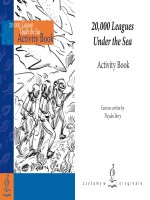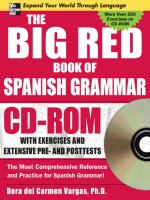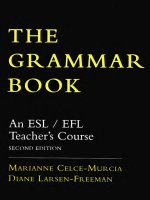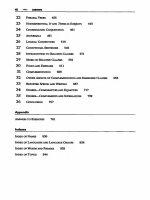Cambridge - The grammar activity book (bob obee)
Bạn đang xem bản rút gọn của tài liệu. Xem và tải ngay bản đầy đủ của tài liệu tại đây (13.13 MB, 128 trang )
The Grammar
Activity Book
Bob Obee
PUBLISHED BY THE PRESS SYNDICATE OF THE UNIVERSITY OF CAMBRIDGE
The Pitt Building, Trumpington Street, Cambridge CB2 1RP, United Kingdom
CAMBRIDGE UNIVERSITY PRESS
The Edinburgh Building, Cambridge CB2 2RU, United Kingdom
40 West 20th Street, New York, NY 10011–4211, USA
10 Stamford Road, Oakleigh, Melbourne 3166, Australia
© Cambridge University Press, 1999
The pages in this book marked ‘From The Grammar Activity Book by Bob Obee © Cambridge University Press
1999 ’ may be photocopied free of charge for classroom use by the purchasing
individual or institution. This permission to copy does not extend to branches or additional schools of an
institution. All other copying is subject to permission from the publisher.
First published 1999
Printed in the United Kingdom at the University Press, Cambridge
ISBN 0 521 575796
PHOTOCOPIABLE
The Grammar Activity Book
Map of the book
KEY : E=ELEMENTARY; P=PRE-INTERMEDIATE; I=INTERMEDIATE; U=UPPER-INTERMEDIATE
Activity title Language focus Level Time Page
(minutes)
Introduction 6
Unit 1 Time like the present
1.1 Global animal bingo Present simple/questions E–P 20 8
1.2 Wildlife whoppers Present simple: facts I–U 25 10
1.3 Adverb backgammon Time adverbs/simple/continuous I–U 25 12
1.4 Behind the screen Present simple/continuous E 20 14
Unit 2 Questions and answers
2.1 So what’s the question? Phrasing of common questions P–I 30 15
2.2 Sporting chances Present continuous questions P–U 25 18
2.3 Do card quiz Subject questions P–I 40 20
2.4 Zig-zag questions Appropriate short answers P 25 22
Unit 3 Talking about things past
3.1 Round about when Time adverbs: simple past P–I 20 24
3.2 Joke go-betweens Simple past questions I 25 26
3.3 Last week’s news Simple past/past continuous P–U 30 28
3.4 Past identities Past continuous: background detail P–I 30 29
Unit 4 Making comparisons
4.1 Line up accordingly Comparative adjectives/adverbs P 25 30
4.2 Psychic partners Superlative adjectives/adverbs I 30 32
4.3 Comparative short straws Degrees of comparison U 20 34
4.4 Ratio roulette Degrees of comparison I 20 36
Unit 5 Describing things
5.1 Sort yourselves out Adverbs: word order E–U 25 37
5.2 Four-card adjectives Order of adjectives P–I 25 38
5.3 Collocation bridges Adjective/noun collocation I–U 15–20 40
5.4 Square routes Use of adjectives/adverbs P–I 25 42
Unit 6 Looking to the future
6.1 Arrangement squares Present continuous (future) P 20 44
6.2 Pantomime fish Use of will P–I 25 46
6.3 Collecting evidence Be going to (present evidence) P 25 48
6.4 Dedication poem Conjunctions/use of will I–U 25 50
Unit 7 Using the perfect
7.1 Point in a story Present perfect simple (just/already/yet) P–I 20 51
7.2 Record-breakers Present perfect simple (unspecified past time) P–I 20 52
7.3 What have you done! Present perfect simple (present result) P 20 56
7.4 Jigsaw mischief Present perfect continuous (present effect) I–U 30 58
7.5 Adverb rummy Present perfect simple/continuous/past simple I–U 20 60
Activity title Language focus Level Time Page
(minutes)
Unit 8 Things we can count
8.1 Determiner dominoes Use of determiners P–U 25 62
8.2 Pieces of me Partitive nouns I–U 25 64
8.3 Building captions Use of the/zero article I 25 66
8.4 Open ‘the’ doors Use of zero article with certain classes of nouns I–U 10–15 68
Unit 9 Conditional meanings
9.1 Homophone healing zero conditional I 30 70
9.2 Blanks and brackets First conditional (if/will/in case) I 20 72
9.3 Seeking scruples Second conditional I 35 74
9.4 Memory consequences Third conditional I–U 20 76
Unit 10 Obligation and possibility
10.1 Headline investment Must/can’t/might/could (possibility) I 25 78
10.2 Streetwise surveys Must/mustn’t/have to … (obligation) P–I 30 80
10.3 Royal behaviour Must have/couldn’t have (past speculation) I–U 20 82
10.4 Rules and lines Must/mustn’t/have to (obligation) I 25 84
Unit 11 Indicating time, movement and place
11.1 Last card wins Prepositional phrases: time place manner P–I 25 86
11.2 Opposite moves Verbs of movement (prepositions) U 25 88
11.3 Time pieces In at on (time) P–I 25 90
11.4 Preposition chequers In at on (place) P–I 25 92
Unit 12 Using the passive
12.1 Signs of the passive Use of passive in signs/different tenses I 25 95
12.2 Whose house? Simple past/past perfect passive U 30 98
12.3 A causative day out Causative structure: have things done U 25 100
12.4 Fairytale jigsaw races Simple past passive by + agent I–U 30 102
Unit 13 Functional exchanges
13.1 Answer keys Short exchanges P–I 25 104
13.2 On the floor debate Common discussion markers I–U 30 106
13.3 Conversation pyramids Short answers and follow-ups P–I 15–20 108
13.4 Answer hopping So/neither responses/tag questions E–P 25 110
Unit 14 What someone said
14.1 Beyond belief You said/told me that … I 25 112
14.2 No more than seven words Sentence patterns after reporting verbs I–U 30 114
14.3 Connecting speech Contrasts between say, tell, speak, talk I–U 25 116
14.4 Who asked you … Reported questions I–U 30 119
Unit 15 Revision games
15.1 Slide rules Various structures I–U 25 120
15.2 Tense squares Revision of tenses P–U 20 122
15.3 Throw-out puzzles Various structures P 30 124
15.4 Sole mates Various structures E–I 35 126
1
leaves seals
long grass dancing queen
BINGO
long grass
sitting
down
bamboo seals
Before class
Make one copy of one Bingo card (p.9) for each learner or each pair
of learners, depending on the size of the class.
In class
1
Explain to learners that they are going to play a game like bingo, which is
popular throughout the English-speaking world. The game here, however, also
involves learners asking questions. If bingo, or an equivalent, is played in your
country, you can tell learners about it.
2
Give each learner a Bingo card. On it there is a grid of phrases. Beneath the
grid is a sentence about an animal and three pieces of information about that
animal: what it has/has got, eats, likes doing, or where or how long it lives.
During the game, each learner will assume the identity of the animal on
his/her card.
3
The aim of the game is to be the first learner to cross off all the phrases on
his/her Bingo card and tell the class which animal each phrase referred to.
4
During the game, each ‘animal’ must introduce himself/herself. However, it is
very important that learners do not reveal any other details about the animal.
On introduction, other learners in the class should pose questions to the
animal, based on phrases in their Bingo cards. For example, for the African
elephant, the following is written:
Hello, I’m an African elephant: I have a small tail, I eat leaves and I’ve got
relatives in India.
The learner introducing himself/herself says: Hello, I’m an African elephant …
The other learners then scan their Bingo cards for any phrases that might
relate to the African elephant, and ask the elephant any questions that the
phrases suggest.
A learner with these bingo squares thus might ask: Do you eat leaves?
The African elephant answers: Yes, I do. (This is a detail on the card.)
and all the learners who have this bingo square can cross it off.
Another learner with these same bingo squares might ask: Do you eat
long grass?
The African elephant answers: No, I don’t (because this is not a detail in
front of him/her).
After a question from three or four different learners, move on to another
learner, who introduces himself/herself: Hello, I’m a polar bear, and so on.
5
If there is more than one African elephant etc. in the class, this simply
means that learners may ask the African elephant questions again.
1
1.1
Global animal
bingo
unit 1 Time like the present
Level
elementary –
pre-intermediate
Class size
whole class
Language focus
present simple Have … got
questions about facts and
habitual actions
Pronunciation
weak forms: do you /dju/
you /j´/
Preparation time
5 minutes
Game time
20 minutes
8
PHOTOCOPIABLE
From
The Grammar Activity Book
by Bob Obee © Cambridge University Press 1999
9
1.1 Global animal bingo
Bingo cards
✂
1
small
tail
grass
long grass dancing queen
BINGO
under
ice
sitting
down
bamboo seals
Hello, I’m a pelican: I live in Romania, I eat fish and
I like going on holiday.
3
holiday
longer than
people
leaves fish
yellow and
brown
BINGO
China
Romania long sleep seals
Hello, I’m a bee: I have a queen, I like dancing
and I like flowers.
4
dancing under ice
zebras leaves
white
relatives
BINGO
grass
flowers small birds long sleep
Hello, I’m a giant panda: I live in China, I eat
bamboo and I like sitting down.
2
leaves
relatives
in India
zebras fish
longer than
people
BINGO
Romania
holiday queen group
Hello, I’m an African elephant: I have a small tail.
I eat leaves and I’ve got relatives in India.
7
long grass under ice
relatives
in India
China queen
BINGO
zebras
small
birds
sitting
down
fish
Hello, I’m a tortoise: I live longer than people,
I have a yellow and brown shell and a long neck.
8
dancing Romania
yellow and
brown
small birds seals
BINGO
long grass
long neck
relatives in
India
grass
Hello, I’m a lion: I live in a group, I like long grass
and I eat zebras.
5
holiday bamboo
white
relatives
grass small birds
BINGO
long grass
leaves small tail group
Hello, I’m a polar bear: I like swimming under ice,
I eat seals and I like a long sleep.
6
China
relatives
in India
flowers
longer than
people
group
BINGO
under ice
sitting
down
small tail long sleep
Hello, I’m a rhinoceros: I eat grass, I have white
relatives and I like small birds on my back.
✂
✂
✂









